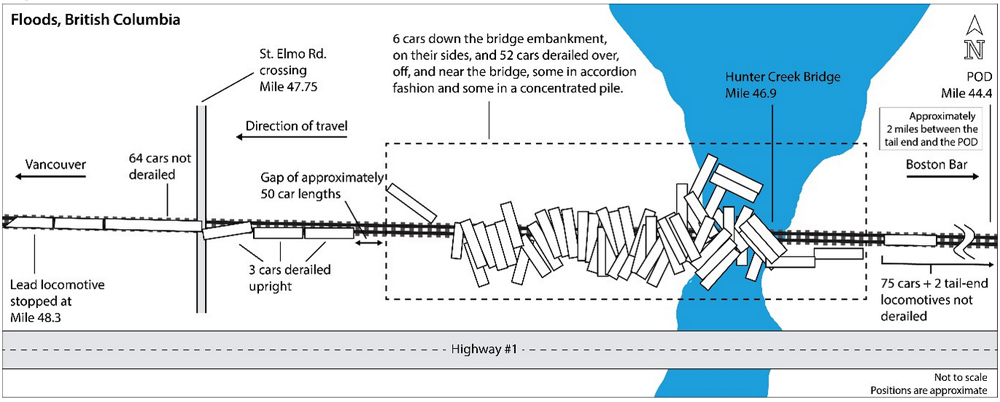
VANCOUVER, British Columbia — A broken wheel led to the derailment of 61 cars of a Canadian National potash train near Floods, B.C., in the Fraser River Canyon in a 2020 incident, the Transportation Safety Board of Canada determined in its final accident report.
The report on the Sept. 14, 2020, derailment of the Vancouver-bound train was released Tuesday, Feb. 27. No injuries occurred and no hazardous materials were involved. The derailment resulted in a spill of about 6 million kilograms (more than 6,600 tons) of potash from 58 of the 61 derailed cars.
The train was traveling at about 50 mph on CN’s Yale Subdivision at about 4:33 a.m. when a train-initiated emergency brake application occurred around milepost 47.7; subsequent crew inspection determined the 65th through 125th cars of the 200-car train, which had two head-end locomotives, and two distributed-power units at the rear. The first car to derail, CNPX 3373, was found to have one wheel missing 1.75 inches of rim width on its entire circumference. This car had been the subject of a warm wheel warning from a wheel temperature detector at Komo (mile 13.8); the crew had been directed to make a 10 psi brake pipe reduction to release a possible stuck air brake; temperatures were lower, but still above normal, at two subsequent detectors.
The TSB subsequently determined that the elevated wheel temperatures were likely because of a hand brake that had inadvertently been left fully applied from the train’s stop in Boston Bar, B.C.. This likely led to the growth of existing cracks on the wheel that failed, leading to a vertical split rim failure. This led to the car dropping inside the track gauge, causing rail brakes at four weld locations and leading to the derailment of the subsequent cars. (The report gives a far more detailed description of this sequence.)
The board also found that CN procedures for dealing with warm wheels allowed the train to continue without inspection after alerts from three consecutive warm wheel detectors, and notes that Canadian Pacific’s more restrictive procedures requires a train to stop for inspection after a second alert.













The warm wheel warning IMO is significant. Does CN have any idea what cars had hand brakes applied to a section that is attached to the front of any train? The warm wheel warning was on one of the cars of the back section that had hand brakes set.
That should have required a visual inspection of the car not just a 10-pound brake reduction.
In fact, maybe all RRs need to know which cars have had hand brakes set and any warm wheel warnings on a car just past a hand brake release should be taken very seriously. What is the good of any hot box detector if warm wheel warning from a car that just had hand brakes released are ignored? That should apply to all cars when first picked up to be noted that hand brakes were released. That should extend to each time a hand brake is applied to a car then released.
Keeping track of which cars have handbrakes set would be impossible. When switching and building trains, setting and releasing of handbrakes on cars is happening all day long. I am the last person to defend C.N. and any of their “safety policies”, but I’m also realistic.